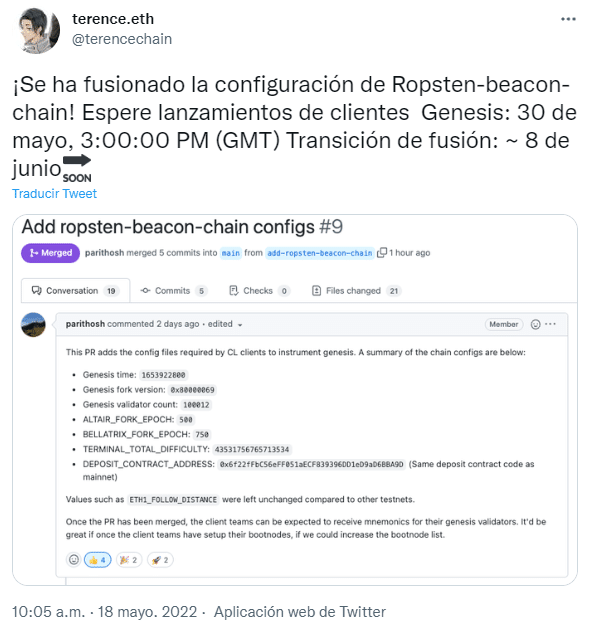
the merger is ready in a test network
- Tech
- May 20, 2022
Ethereum testnet Ropsten is ready to perform the merger (“the merge”). She will be, if everything goes according to plan, the first to execute this transition. Its success or failure would define the date this event hits the mainnet.
The confirmation was given by Ethereum developer Parithosh Jayanthi on his GitHub. This specialist has been in charge of different projects related to fusion, such as the Kiln test network.
Echoing this post, Ethereum programmer Terence Tsao, explain that on May 30th Ropsten-beacon-chain will be launched, which would be the equivalent of the Ropsten network of Ethereum 1.0, but executed through the validators, which replace the miners in the proof of stake (PoS). By June 8, Ropsten would have its merger, which involves the migration of proof of work (PoW) to PoS.
Before the launch of the new Ropsten, Ethereum developers have been running different tests with the aim of evaluating what the merger will look like. One of these was Kiln, a network specially designed to experiment with Ethereum 2.0. Ropsten will be the first of the already existing test networks to test the transition.

The merger, as it is known in the context of Ethereum, is an event that marks the shutdown of PoW and the beginning of PoS. At the moment of this fact, Ethereum accounting will move from the old network with PoW to the new Ethereum 2.0 Beacon Chain. In the process, mining will be left behind, which will be replaced by staking.
According to some predictions, this could happen in the second half of the current year. As a side effect, ether (ETH), the network’s native cryptocurrency, would become deflationary since then.
The difficulty bomb will define the future of fusion
Along with the tests that the developers have been conducting to define the execution of the merge, an event that will be the predecessor of this stage is the difficulty bomb.
This stage would mark the end of PoW mining by the increase of the difficulty for mining blocks, leading to what is known as the “ice age”, in which the Ethereum network no longer mines a single block, that is, it is paralyzed. At this time it will be when the merger takes place and thethe Ethereum 2.0 validators come into play.
As reported by Criptonews, the difficulty bomb is scheduled to be activated on June 30. However, it could be postponed if deemed necessary, as has happened in the past.
